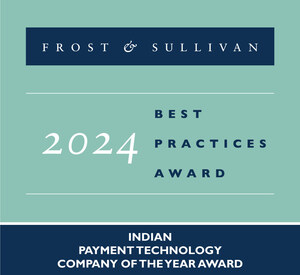Industry Transformation, Software Defined Everything, the Internet of Things and Cybersecurity to offer greatest opportunities in APAC for 2015, says Frost & Sullivan
SINGAPORE, Nov. 27, 2014 /PRNewswire/ -- Digital disruption is set to be the norm across industries as they look to transform to keep their business relevant amidst the ever changing technological landscape. The implementation of enabling technologies such as low cost sensors, cloud computing, advanced data analytics and mobility are expected to drive this revolution.
Key examples of industries expected to undergo IT driven transformations include Energy (Smart Grids), Media (Content Streaming) and Manufacturing (3D Printing), all of which will be influenced by the Internet of Things.
Mr. Andrew Milroy, Senior Vice President, ICT Practice, Asia Pacific at Frost & Sullivan identifies 5 key areas that will be driven by the influence of the Internet of Things.
"By 2017, the Internet of Things (IoT) market will be one of the fastest growing segments in the Asia Pacific technology industry. The total Asia Pacific spending on IoT spending is forecasted to be US$59 billion by 2020. This offers real opportunities, especially in areas of manufacturing and consumer technology, which are expected to be two of the fastest growing segments over the next two years," opined Mr. Milroy.
The level of digitization in the manufacturing industry has not kept up with the pace of other industries such as telecoms but the onset of Industry 4.0 is set to change that. Various initiatives by organizations such as the Smart Manufacturing Leadership Coalition (SMLC), aim to bring together stakeholders to develop the measures needed to facilitate the broad adoption of manufacturing intelligence.
Besides manufacturing, the wearables market is also experiencing strong growth. Frost & Sullivan estimates the global wearable technology market at US$8.58 billion in 2014 and will reach US$38 billion in 2017 with a CAGR of 34% from 2014 to 2018. According to Mr. Milroy, the Asia Pacific region accounts for just over 4% of the global market and will lag behind other mature markets in North America and Europe in the uptake of wearables, which are currently dominated by standalone devices such as activity trackers and wearable recordings.
"It is expected that wearables such as smart watches and smart glasses with a wider range of functions will eventually overtake all other wearable devices to adopt a premium position in the market. Notably, the smart glasses are anticipated to do extremely well, with many promising application opportunities across industries such as healthcare and manufacturing," noted Mr. Milroy.
2015 is seen to be the year of software-defined everything as the software defined revolution spreads beyond the boundaries of the data centres. Programmable networks will enable the creation of new business applications and services which will drive efficiencies and new service models.
The adoption of the Internet of Things is however not without its challenges, as there are several hurdles that could prevent it from achieving rapid growth. Security and information privacy are some of the largest hurdles to the adoption of IoT. With smart and connected devices embedded in business processes and tied to critical functions, the ability to negatively affect enterprises and individuals is increased significantly.
Mobile Outlook 2015
Traditional mobile communications revenue comprising of voice and non-voice (mobile data and SMS services) was estimated to be US$567 billion in 2014. The market will continue to grow, albeit at a modest rate of 2.7% over a 5-year CAGR to reach US$627 billion by 2018. To buffer the decline in voice and SMS, data consumption is expected to drive revenue growth across most of Asia, with key factors including LTE services, smartphone proliferation and an increase in the consumption of multimedia content such as real time gaming and video entertainment; all of which are bandwidth intensive especially for larger screen devices.
In particular, Mr. Ajay Sunder, Vice President of Telecoms, Frost & Sullivan Asia Pacific pointed out that data driven devices, rise of the digital consumer and declining revenue per unit of data are key trends that service providers should take note in devising their strategy in the digital era.
"Whilst falling smartphone prices, generous telecom plans and a high smartphone penetration rate of 72% in Singapore provides growth opportunities for service providers to generate revenue through digital media, they must be mindful of the exponential data surge and resulting network congestion which will compromise the quality of experience that is expected in a mature market like Singapore," Mr. Sunder noted.
2015: Data Driven Devices
Smartphone penetration across the region is steadily rising, along with a growing number of smart devices. These data driven devices are accelerating the shift from voice to data usage transition. "The multi-screen trend continues as consumers benefit from declining prices especially with popularity of new brands such as Xiaomi. Rising smartphone users are causing a faster shift from voice heavy users to data heavy users especially in the more developed markets," said Mr. Sunder.
"Vendors that are able to support the seamless sharing of content and applications across multiple devices will have an advantage. Nevertheless, with the recent popularity of phablets (hybrid of smartphones and tablet), there is a trend towards multi-tasking on a single device," he added.
As the growth in data is leading to an increase in ARPU for operators, revenue per incremental MB is falling. Operators are buffering the decline with multi-SIM packages to take advantage of the multi-device trend. However, the consolidation of devices via a phablet may challenge that strategy.
2015: Rise of the Digital Consumer
The usage of social media is becoming more prevalent across Asia with Facebook being the most popular social media platform in many countries. In view that 59% of the 3.2 million Internet users in Singapore uses Facebook, service providers are increasingly leveraging upon social media platform as an important tool in their promotion and marketing campaigns.
"Besides social media, there is a growing necessity for service providers to re-evaluate their reliance on traditional mobile services and invest in new areas of growth. The Internet of Things offers opportunities across different industry verticals such as transportation because the service provider sits right in the middle of the eco-system," said Mr Sunder.
"Service providers have to move beyond their comfort zones and establish partnerships with third parties such as vendors, device makers and chip set modules providers in developing an ecosystem that will incentivize the proliferation of value-added service that consumers and enterprises are willing to pay to fill the void in traditional revenue," Mr Sunder added.
About Frost & Sullivan
Frost & Sullivan, the Growth Partnership Company, works in collaboration with clients to leverage visionary innovation that addresses the global challenges and related growth opportunities that will make or break today's market participants. For more than 50 years, we have been developing growth strategies for the global 1000, emerging businesses, the public sector and the investment community. Is your organization prepared for the next profound wave of industry convergence, disruptive technologies, increasing competitive intensity, Mega Trends, breakthrough best practices, changing customer dynamics and emerging economies? Contact us: Start the discussion
Media contact:
Melissa Tan
Corporate Communications – Asia Pacific
P: +65 6890 0926
E: [email protected]
To view the original version on PR Newswire, visit:http://www.prnewswire.com/news-releases/industry-transformation-software-defined-everything-the-internet-of-things-and-cybersecurity-to-offer-greatest-opportunities-in-apac-for-2015-says-frost--sullivan-300002121.html
SOURCE Frost & Sullivan
Related Links
WANT YOUR COMPANY'S NEWS FEATURED ON PRNEWSWIRE.COM?
Newsrooms &
Influencers
Digital Media
Outlets
Journalists
Opted In





Share this article